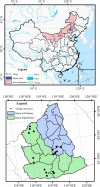Medicinal wild plants used by the Mongol herdsmen in Bairin Area of Inner Mongolia and its comparative study between TMM and TCM
- PMID: 31269968
- PMCID: PMC6609360
- DOI: 10.1186/s13002-019-0300-9
Medicinal wild plants used by the Mongol herdsmen in Bairin Area of Inner Mongolia and its comparative study between TMM and TCM
Abstract
Background: Ethnobotanical studies on folk medicinal plants used by Mongol herdsmen have been conducted in some areas of Inner Mongolia and Xinjiang, China. However, ethnobotanical findings are preliminary and not comprehensive. Mongolian medicinal botanical knowledge has been gradually decreasing. One of the most important reasons is that Mongolian traditional medicine has become an alternative medicine in pasturing areas of China. Collection and analysis of Mongolian folk medicinal botanical knowledge have become extremely important.
Methods: From 2008 to 2014, the authors have been to Bairin Right Banner seven times, and from 2016 to 2018, have been to Bairin Left Banner five times. Fieldwork was carried out in 18 villages, and 136 local Mongol herdsmen were interviewed. The methods of free-listing and open-ended questionnaires were used in field survey. Ethnobotanical interview and voucher specimen collections were organized in two ways: local plant specimens were collected beforehand and then interviews were organized; local Mongol herdsmen were invited to the field and were interviewed while collecting voucher specimens. Mongolian was used as the working language, and findings were recorded in Mongolian. Scientific names of plants were confirmed through collection and identification of voucher specimens.
Results: Among the collected medicinal wild plants, 40 species are used by local Mongol herdsmen. Twenty-six species of folk medicinal plants have been recorded in the literature in the field of Traditional Mongolian Medicine (TMM), and 38 species have been recorded in the field of Traditional Chinese Medicine (TCM). The parts that have medicinal value include roots, whole plant, aerial parts, leaves, fruit, seeds, branches, bulb skin, and stem. For medicinal efficacy, among the collected medicinal plants, 8 species should be fresh. Thirteen species must be dried, and another 16 species can be fresh or dried. After a simple process of sorting and washing, local people soak, pulverize, and mash the medicinal plants. Nineteen species were externally used medicine, and 17 species were internally used medicine (taken orally). Generally, only one or two functions of folk medicine and indications associated with it were provided by local Mongol herdsmen. However, the functions of TMM and TCM and their indications show diversity and have systematic characteristics. More functions of TMM and TCM and their indications have been recorded. In the paper, we also discuss the correspondence between one or two functions of folk medicine with one or two functions of TMM and TCM.
Conclusion: Not many medicinal wild plant species are used by Mongol herdsmen in the Bairin Area. Fourteen species have not been recorded in the literature of TMM, and 2 species have not been recorded in the literature of TCM. Folk knowledge can provide a certain reference value for searching for new medicinal wild plant species. On the whole, fresh plants are commonly used by Mongol herdsmen in the Bairin Area; boiling is the most common preparation method. Most of the crude materials can be used alone. The externally used medicinal parts are more common than those taken orally. A folk medicinal bath may be regarded as a compound drug mixed with two to five species of plant materials. The local Mongol herdsmen fully understand the function of folk medicines and their indications.
Keywords: Bairin Area; Folk medicine; Mongol herdsmen; TCM; TMM; Wild plants.
Conflict of interest statement
The authors declare that they have no competing interests.
Similar articles
-
Wild plant folk nomenclature of the Mongol herdsmen in the Arhorchin National Nature Reserve, Inner Mongolia, PR China.J Ethnobiol Ethnomed. 2013 Apr 24;9:30. doi: 10.1186/1746-4269-9-30. J Ethnobiol Ethnomed. 2013. PMID: 23628479 Free PMC article.
-
Indigenous knowledge for plant species diversity: a case study of wild plants' folk names used by the Mongolians in Ejina desert area, Inner Mongolia, P. R. China.J Ethnobiol Ethnomed. 2008 Jan 16;4:2. doi: 10.1186/1746-4269-4-2. J Ethnobiol Ethnomed. 2008. PMID: 18199323 Free PMC article.
-
Ethnobotanical profiles of wild edible plants recorded from Mongolia by Yunatov during 1940-1951.Hist Philos Life Sci. 2021 Aug 11;43(3):100. doi: 10.1007/s40656-021-00428-0. Hist Philos Life Sci. 2021. PMID: 34382157 Free PMC article. Review.
-
A historical and ethnobotanical study on local botanical knowledge recorded in the book "Mongolia and Amdo and the Dead City of Khara-Khoto".J Ethnobiol Ethnomed. 2021 May 25;17(1):36. doi: 10.1186/s13002-021-00443-2. J Ethnobiol Ethnomed. 2021. PMID: 34034764 Free PMC article.
-
An overview on ethnobotanico-pharmacological studies carried out in Morocco, from 1991 to 2015: Systematic review (part 1).J Ethnopharmacol. 2021 Mar 1;267:113200. doi: 10.1016/j.jep.2020.113200. Epub 2020 Aug 1. J Ethnopharmacol. 2021. PMID: 32750461
Cited by
-
Wild edible plants collected and consumed by the locals in Daqinggou, Inner Mongolia, China.J Ethnobiol Ethnomed. 2020 Oct 9;16(1):60. doi: 10.1186/s13002-020-00411-2. J Ethnobiol Ethnomed. 2020. PMID: 33036666 Free PMC article.
-
Exploring the Use of Iris Species: Antioxidant Properties, Phytochemistry, Medicinal and Industrial Applications.Antioxidants (Basel). 2022 Mar 9;11(3):526. doi: 10.3390/antiox11030526. Antioxidants (Basel). 2022. PMID: 35326175 Free PMC article. Review.
-
"A herder's duty is to think": landscape partitioning and folk habitats of Mongolian herders in a mountain forest steppe (Khuvsugul-Murun region).J Ethnobiol Ethnomed. 2019 Nov 20;15(1):54. doi: 10.1186/s13002-019-0328-x. J Ethnobiol Ethnomed. 2019. PMID: 31747913 Free PMC article.
References
-
- World Health Organization. WHO global report on traditional and complementary medicine 2019. World Health Organization. [http://www.who.int/iris/handle/10665/312342]
-
- Rakotoarivelo NH, Rakotoarivony F, Ramarosandratana AV, Jeannoda VH, Kuhlman AR, Randrianasolo A, Bussmann RW. Medicinal plants used to treat the most frequent diseases encountered in Ambalabe rural community, Eastern Madagascar. J Ethnobiol Ethnomed. 2015;11:68. doi: 10.1186/s13002-015-0050-2. - DOI - PMC - PubMed
Publication types
MeSH terms
LinkOut - more resources
Full Text Sources
Medical


